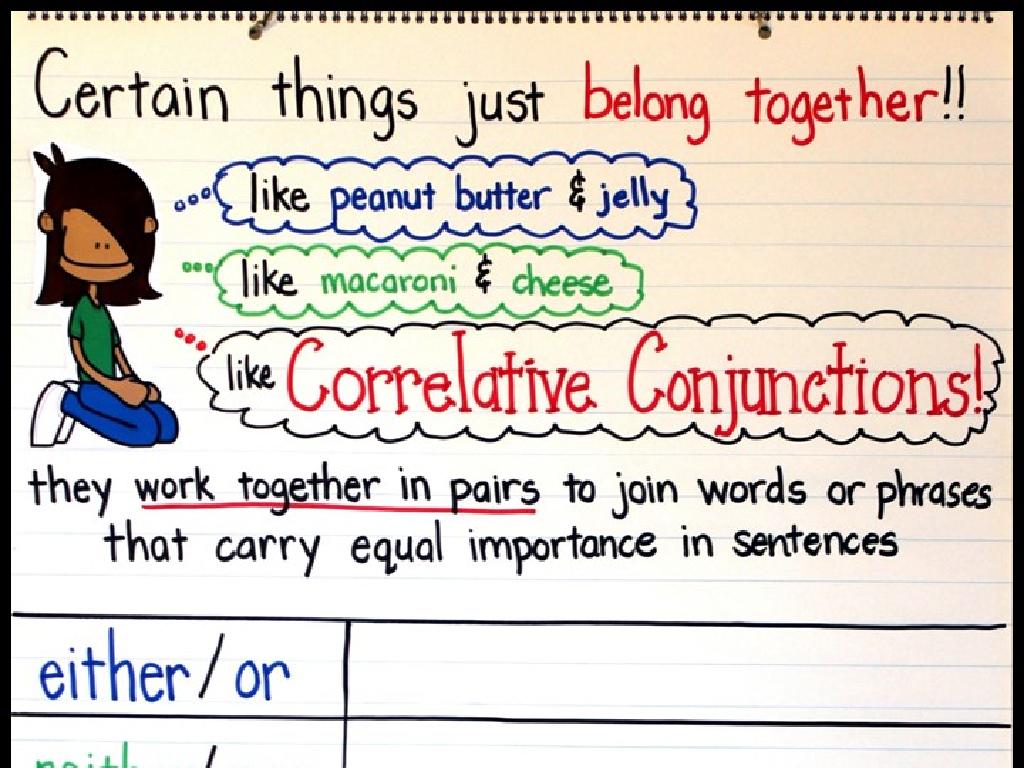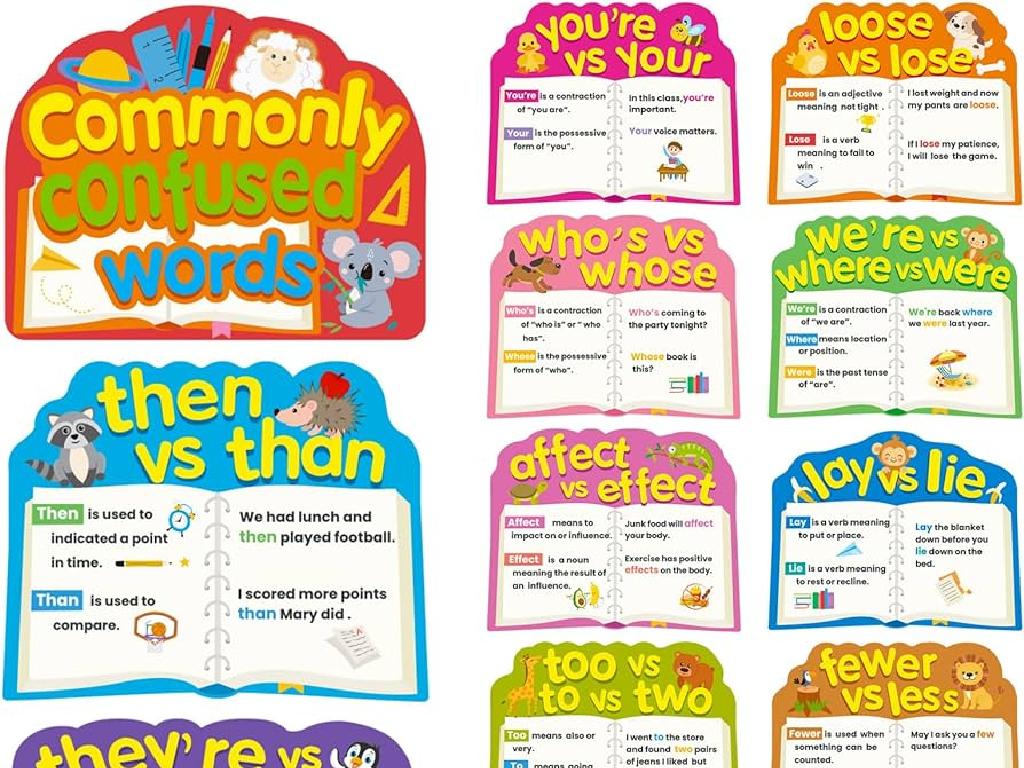Relate Division And Fractions
Subject: Math
Grade: Fifth grade
Topic: Understand Fraction Division
Please LOG IN to download the presentation. Access is available to registered users only.
View More Content
Welcome to Fraction Division!
– Linking division and fractions
– Division is like breaking a whole into equal parts.
– Division aids fraction understanding
– Knowing how to divide helps us split whole numbers into fractions.
– Today’s objective: Relate division to fractions
– We’ll learn how division creates fractions and vice versa.
|
This slide introduces the concept of fraction division by explaining the relationship between division and fractions. Emphasize that understanding division is crucial as it is the basis of creating fractions dividing a whole into equal parts. Illustrate with simple examples, such as dividing a pizza into slices. Today’s learning objective focuses on relating the process of division to the concept of fractions, ensuring students can transition from whole number division to dividing fractions. Encourage students to think of division as another way to represent fractions, and vice versa. Provide examples such as dividing 2 by 4 can also be seen as 2/4 or 1/2.
Understanding Fractions
– A fraction is part of a whole
– Like a slice of pizza from a whole pie
– Numerator and denominator explained
– Top number (numerator) is the part you have, bottom number (denominator) is the total parts
– Examples: 1/2, 3/4, 5/8
– 1/2 means half, 3/4 means three quarters, 5/8 means five out of eight parts
|
Begin the lesson by explaining that a fraction represents a portion of a whole, using tangible examples like slices of pizza or pieces of fruit to illustrate the concept. Clarify the roles of the numerator and denominator, ensuring students understand that the numerator indicates how many parts are being considered, while the denominator shows the total number of equal parts in the whole. Provide simple, relatable examples of fractions to help solidify their understanding. Leave the fourth bullet point empty as the first three points cover the necessary introduction to fractions.
Understanding Division and Fractions
– Division: Splitting into equal parts
– Division as ‘fair sharing’
– Example: 12 ÷ 4 equals 3
– 12 items shared by 4 people, each gets 3
– Relating division to fractions
– Division is like a fraction, 12 ÷ 4 is the same as 12/4
|
This slide introduces the concept of division as a method of splitting a whole into equal parts or groups, which is a foundational skill in understanding fractions. Emphasize the idea of ‘fair sharing’ to help students visualize the division process. Use concrete examples, such as dividing 12 apples among 4 children, to illustrate that each child would receive 3 apples. This sets the stage for understanding that division is directly related to fractions, as dividing 12 by 4 can also be represented as the fraction 12/4, which simplifies to 3. Encourage students to think of division problems they encounter in their daily lives and how those can be expressed as fractions.
Relating Division to Fractions
– A fraction represents division
– Numerator divided by denominator
– Example: 3/4 as division
– 3/4 shows how 3 is divided into 4 parts
– Understanding fractions as division
– Grasping this concept simplifies fraction operations
|
This slide introduces the concept that a fraction is another way to represent division. The numerator (top number) can be seen as the dividend, and the denominator (bottom number) as the divisor. For example, 3/4 can be understood as 3 divided by 4. This foundational understanding is crucial as it helps students to simplify complex fraction operations and builds a bridge to more advanced mathematical concepts involving fractions. Ensure that students can visualize this division by using pie charts or other visual aids. Have them practice by converting simple fractions to division expressions and vice versa.
Dividing Whole Numbers by Fractions
– Understanding division by fractions
– Division by a fraction finds how many pieces fit into the whole.
– How many fractions fit into a whole?
– Imagine dividing a pizza into smaller slices; how many slices make up the whole pizza?
– Example: Dividing 5 by 1/2
– 5 ÷ 1/2 asks how many halves make 5 whole ones.
|
This slide aims to help students grasp the concept of dividing whole numbers by fractions by visualizing and contextualizing the process. Start by explaining that division by a fraction is like finding out how many pieces of a certain size are needed to make up a whole. Use relatable examples such as slicing a pizza or a cake to illustrate the concept. For the example 5 ÷ 1/2, guide students to understand that they are looking for the number of half units that make up 5 whole units. This can be visualized by imagining 5 whole pizzas and determining how many half-pizzas can be made from them. Encourage students to draw pictures or use physical objects to better understand the concept. The goal is for students to feel comfortable with the idea that dividing by a fraction is the same as multiplying by its reciprocal.
Dividing Fractions by Whole Numbers
– Understanding division with fractions
– Dividing a fraction by a whole number
– We find a part of the fraction, making it smaller
– Example: 1/2 ÷ 4
– What is one-fourth of 1/2? It’s 1/2 divided by 4
– Finding a smaller part of a fraction
– This means how many times does 4 fit into 1/2?
|
This slide introduces the concept of dividing fractions by whole numbers. Start by explaining that division can be thought of as finding a smaller part of something. When we divide a fraction by a whole number, we are essentially looking for a portion of that fraction. For example, if we have 1/2 and we want to divide it by 4, we are asking, ‘What is one-fourth of 1/2?’ This can also be understood as how many times the whole number fits into the fraction. It’s important to use visual aids, such as pie charts or fraction bars, to help students visualize this concept. Encourage students to think of real-life examples where they might need to divide a fraction by a whole number, such as cutting a pizza into smaller pieces.
Fraction Division Practice
– Solve 5 ÷ 1/3
– How many 1/3s are in 5?
– Solve 2/5 ÷ 2
– What is half of 2/5?
|
This slide is designed to provide students with practice problems on dividing whole numbers by fractions and fractions by whole numbers. For the first problem, guide the students to understand that dividing by a fraction is the same as multiplying by its reciprocal. Therefore, 5 ÷ 1/3 is the same as 5 × 3/1, which equals 15. For the second problem, explain that dividing a fraction by a whole number is like multiplying by the reciprocal of the whole number. So, 2/5 ÷ 2 is the same as 2/5 × 1/2, which simplifies to 1/5. Encourage students to visualize these problems with drawings or models if necessary. Provide additional examples if time allows and ensure that students are comfortable with the concept before moving on.
Class Activity: Fraction Division Art
– Create a fractional art piece
– Use division for art sections
– Divide paper into parts like 1/2 or 1/4 to plan your art
– Share your art with the class
– Explain your fractions and divisions
– Tell us how you used division in your art
|
This activity is designed to help students understand the concept of fraction division in a fun and creative way. Provide each student with a piece of paper and instruct them to divide it into fractions, using division to determine the size of each part. They can then create an art piece within these sections, using different colors or patterns. Once completed, students will share their artwork with the class and explain how they used fraction division to create their designs. For example, if a student has divided their paper into 1/2 and then into 1/4, they can explain how the whole was divided into parts. This hands-on activity not only reinforces mathematical concepts but also encourages artistic expression and public speaking skills.
Wrapping Up: Division & Fractions
– Recap: Division relates to fractions
– Homework: Worksheet completion
Practice fraction division with the provided exercises.
– Create Fraction Division Art
Use your creativity to make art that represents fraction division.
– Presentation preparation for next class
Be prepared to explain your art and the fraction concepts it illustrates.
|
As we conclude today’s lesson, remind students of the key concept that division can be represented as fractions. For homework, they should complete the worksheet to reinforce their understanding of fraction division. Additionally, students are tasked with creating an art project that visually represents the concept of fraction division, which they will present in the next class. This activity is designed to solidify their comprehension through a creative process and prepare them to articulate their understanding. Encourage students to be imaginative and to think about how they can use art to express mathematical ideas.





